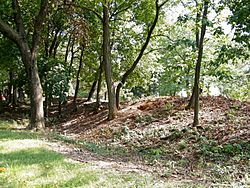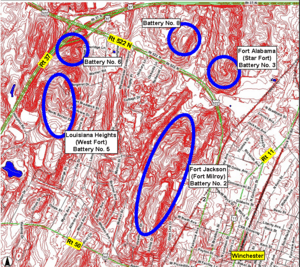Fort Collier facts for kids
Quick facts for kids Fort Collier |
|
|---|---|
| Winchester, Virginia | |

Fortifications at Fort Collier
|
|
| Type | redoubt |
| Site information | |
| Controlled by | Virginia |
| Site history | |
| Built | 1861 |
| In use | 1861–1865 |
| Battles/wars | Third Battle of Winchester |
|
Fort Collier
|
|
| Lua error in Module:Location_map at line 420: attempt to index field 'wikibase' (a nil value). | |
| Nearest city | Winchester, Virginia |
| Area | 10 acres (4.0 ha) |
| Built | 1861 |
| Architectural style | Greek Revival |
| NRHP reference No. | 06000356 |
| Significant dates | |
| Added to NRHP | April 28, 2006 |
Fort Collier was a small fort built during the American Civil War near Winchester, Virginia. It was created by Confederate soldiers and even some captured Union prisoners. This fort was important because it protected the northern entrance to Winchester, especially along a main road called the Martinsburg Pike.
Later, when Union (Federal) troops took over, they called it Battery No. 10. Even though it was on low ground, it served as a key guard post. Confederate General Jubal Early used Fort Collier in his defenses during the Third Battle of Winchester.
Contents
Fort Collier: A Civil War Stronghold
Why Was Fort Collier Built?
Fort Collier was built on land that Benjamin Stine bought in 1859. Soon after, the American Civil War began. Both sides started building many defenses in the northern Shenandoah Valley.
General Joseph E. Johnston, a Confederate leader, decided that Harpers Ferry was too hard to defend. He chose to move his main defenses to Winchester instead. The Stine farm was on high ground near a main road, making it a perfect spot. Confederate Engineer Lieutenant Collier and William Henry Chase picked this location for the new fort.
Building the Fort: 1861
Confederate troops started building Fort Collier on July 7, 1861. Lieutenant Collier, a Confederate engineer, led the work. Interestingly, some captured Union (Federal) prisoners also helped with the construction.
Major William H.C. Whiting, the chief engineer for General Johnston, might have supervised the building. The Army of the Shenandoah occupied the fort during the winter of 1861 and into 1862. General Johnston was in command at this time.
Later, the fort came under the command of Major General Stonewall Jackson. His headquarters were located just south of the fort.
A Glimpse Inside Fort Collier
On August 21, 1861, a woman named Harriet H. Griffith visited the fort. She wrote about her experience in her diary:
I have this day visited the breastworks or fortifications on the Martinsburg Pike with Father and Johnnie. Was exceedingly interested. First work of the kind I'd ever seen. The first time I was ever so near a cannon. I looked into them. There were four cannons planted and much ammunition there. A great many men were working [and I] saw the magazines. They have several rifle ports which seem so secure. I have read of them, but have never seen them. They had several masked batteries. It seems real strong and well built. There is a high embankment of sand bags, barrels, and brush covered with dirt, part sodded over. They intend to sod it with a big ditch on the lower side. They have completely surrounded Stine's House which is now occupied by soldiers, some of whom were working there, come cooking, some washing, some on guard, and some lounging, and some sleeping ... Surely it is something to be remembered, but I hope it will never be used."
– Harriet H. Griffith, Aug 21, 1861
Harriet described seeing four cannons and lots of ammunition. She also saw many soldiers working, cooking, and guarding the fort. She noted the strong walls made of sandbags, barrels, and dirt. She hoped the fort would never be used in a real battle.
Fort Collier During the War: 1862-1864
Changing Hands: 1862
Confederate troops used Fort Collier during the Romney Expedition in early 1862. However, General Jackson left Winchester in March 1862. This happened when Major General Banks's Union forces entered the town.
By May, Jackson returned to Winchester. He defeated the remaining Union troops on May 25. The Union forces chose not to defend Fort Collier during the First Battle of Winchester.
Union Occupation: 1863
From January to June 1863, Union troops under Major General Milroy occupied the fort. They renamed it Battery No. 10. It became part of Milroy's larger defense system for Winchester.
In June, Confederate forces under Lieutenant General Ewell attacked Milroy's command. They shelled the various forts in Winchester, damaging the Stine house. Early the next morning, Milroy abandoned Fort Collier and Winchester. His troops fled north, with Fort Collier being the last fort they left behind.
The Final Battle: 1864
In September 1864, Fort Collier became a Confederate base again. This was during Lieutenant General Jubal Early's Valley Campaigns. Major General Sheridan's Union forces advanced on Winchester on September 17. This forced Early to set up a defensive line.
On September 19, Fort Collier became a key part of Early's defense. His line stretched from Fort Alabama (Star Fort) in the west to trenches east and south of Fort Collier. During the Third Battle of Winchester, a huge Union cavalry charge took place. About 6,000 cavalrymen attacked from the north. This was the largest cavalry charge against infantry in the entire war.
Colonel George S. Patton, the grandfather of a famous World War II general, commanded three regiments defending the fort. Colonel Patton was killed during this intense battle. The Confederate forces at Fort Collier were completely overwhelmed. The fort was captured, and Early's forces had to retreat south through Winchester.
Fort Collier Today
The Fort Collier Civil War Center, Inc. bought 10 acres of the fort's land on April 1, 2002. They received help from a Federal grant, the Civil War Preservation Trust, and private donations.
Today, the center hosts many events and activities. These include the Fort Collier Kids Civil War History Camp, Civil War Haunting events, and the Fort Collier Bluegrass Festival. It helps people learn about this important piece of history.
- Delauter, Roger V., Jr. Winchester in the Civil War. Lynchburg, Virginia. H. E. Howard, Inc., 1992. ISBN: 978-1-56190-033-6
- Mahon, Michael G., Ed. Winchester Divided: The Civil War Diaries of Julia Chase & Laura Lee. Mechanicsburg, PA: Stackpole Books, 2002. ISBN: 0-8117-1394-6
- Noyalas, Jonathan A. Plagued by War: Winchester, Virginia During the Civil War. Leesburg, VA: Gauley Mount Press, 2003. ISBN: 0-9628218-9-6


